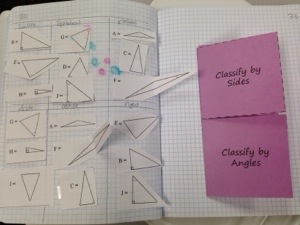Check out Oct 7 of her 180 days of Geometry blog:

I had been doing some things like this, but never had the students keep a special notebook for it. Sometimes these pages would make it into their binders or spiralbound notebooks and sometimes they just went into the deep dark black-hole called BackPack.
This year I have two Geometry classes that have lots of students with special needs. Notetaking was going to be a challenge for them. I felt that I might better assist ALL the students (and maybe even have them refer to their notes) if we had this kind of notebook: page numbered, dated, and filled in.
In my quest for how to be more organized about it, I have come across this site, which has some useful ways for the students to make a table of contents, and has an assortment of rubrics if you decide to grade your students' notebooks. It also has some great activities.
But if you are just starting out with this, then you want to visit Sarah at Everybody is a Genius. WOW. If you have any questions on how to get started, what resources are out there, etc., she has got it all. I have learned so much from her blog!
We had been doing special angle pairs, particularly with parallel lines. I decided to jump right in to special parallelograms (using Sketchpad) so they could see places where some of these special angle pairs show up. They were given an Always Sometimes Never sheet and asked to construct the special parallelograms then make conjectures. I could see at the end of the period we were going to need a way to keep all that amazing information to hand. So this is what I made for their notebooks:

and after we get this into our notebooks, I will have them work with their partners to fill in under the "pie" pieces ( I also put notes on the underside of my pie pieces to remind me what supplementary meant, as well as that funny upside down T symbol!)
On the left side I will give them some problems involving angles and lengths of various parts of diagonals. I think I will give them at least one problem where they will need to use the Pythagorean Theorem to find a side length of the rhombus, since we reviewed the Theorem while doing distance formula.
I don't anticipate being great at this right away. And I am starting it already a month into the course. But, I will learn, they will have a resource, and we will all get better at this as we go.

I love your "pie" foldable idea! I plan to apply it to an upcoming INB page. Thank you so much for checking out my blog and sharing my ideas! That is super exciting to me! Sometimes it is hard to be creative and it gets exhausting. I figure if I plan a few good INB pages per quarter, then it should get increasingly awesome each year. Please keep sharing your ideas too, so that we can each have more time to spend developing more awesome INB pages.
ReplyDelete